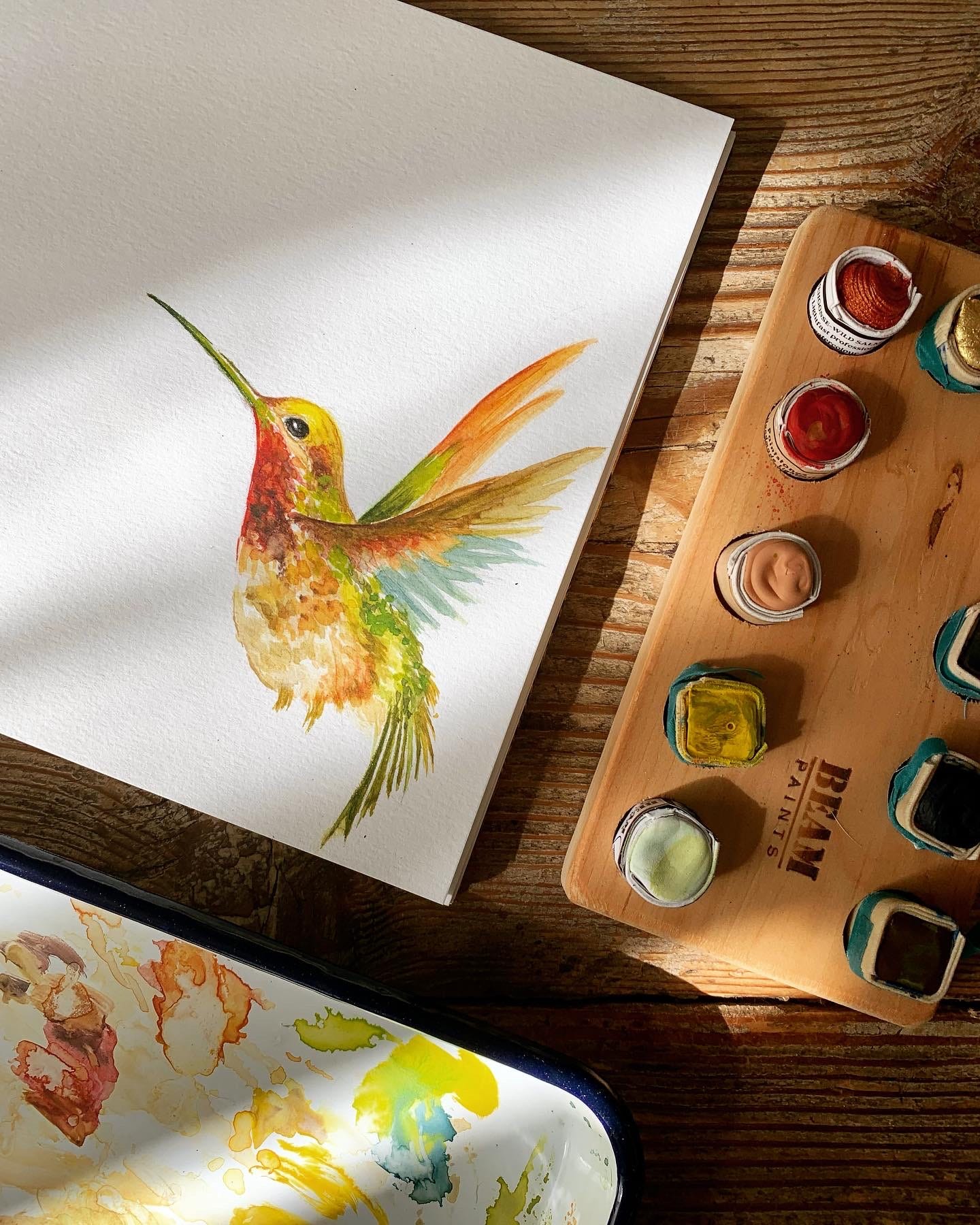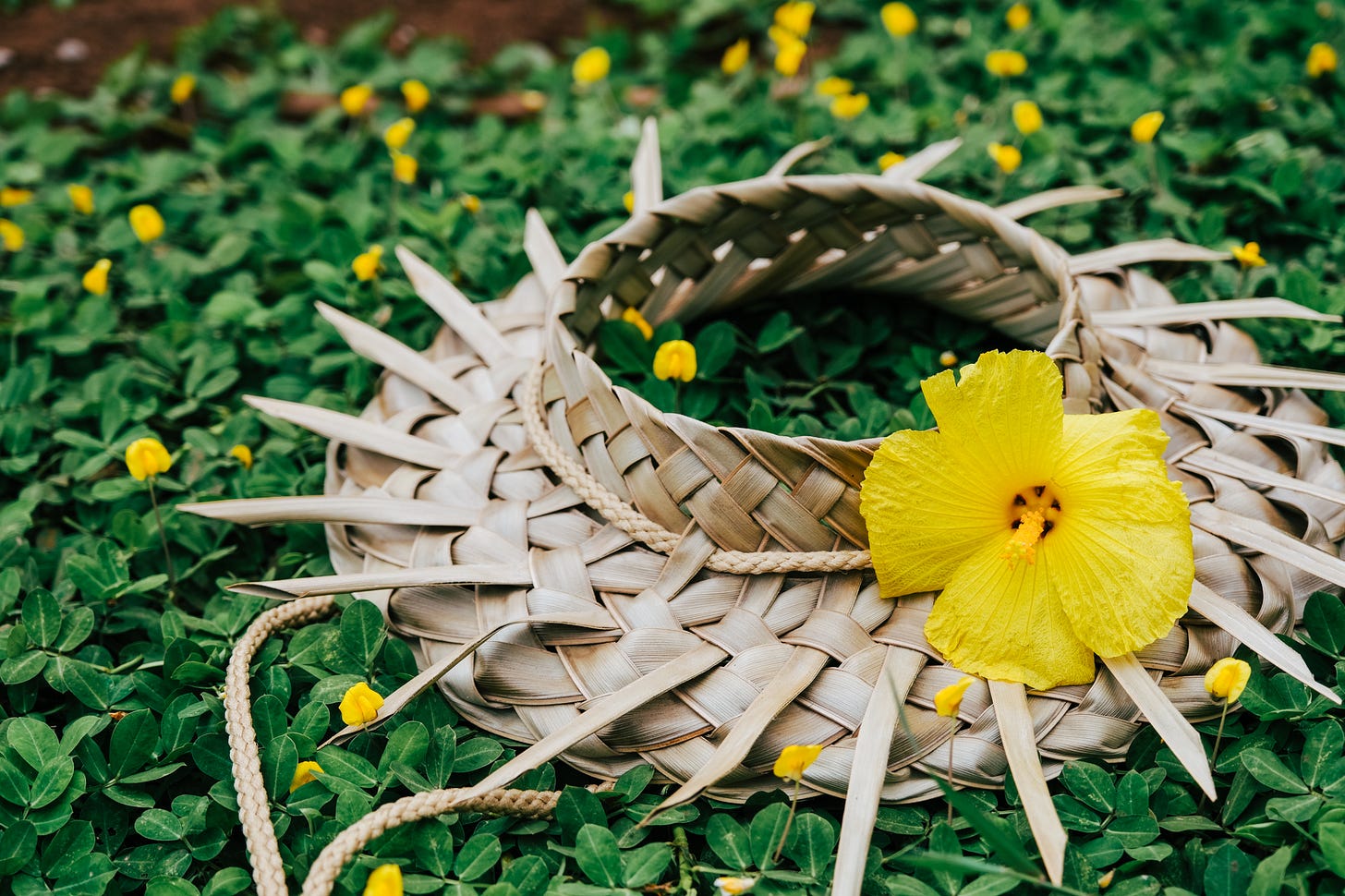My fingers started to stain bright pink and plum as I smeared chunks of ‘akala berries to extract their seeds. Seeing their vibrant colors bleed into the white paper towel, I had an idea. “Why don’t I do this in my sketchbook and simultaneously use these fruit pigments as watercolor?” I thought. I then opened a blank page and continued dragging the berries in meditative strokes across the paper, translating these intimate moments into marks of an artful memento.
Later, my fingertips, and the canvas, darkened to hues of purple and indigo as I processed the seeds of manono and kolea lauliʻi, two other understory plants native to the wet forests of Hawaiʻi. I had collected these seeds a few days prior in support of reforestation efforts in a mountain reserve of Kealakekua.
Perhaps the superficial outcome of this piece may seem like nothing out of the ordinary. But to me, and for those with whom I get to share the background of its spontaneous creation, the painting becomes multidimensional and multi-sensorial beyond the visuals — texturized by stories related to the plants, political ecology, relationships, and memories expressed through its gradients.
Continuing the threads of my last essay on “Regrounding diversity,” this was an exciting invitation to explore possibilities of regrounding the arts in the happenings of place — not just in what they portray but also in their form.
Reversing abstractions and reductionism
As artists and musicians increasingly contribute their voices and work to the various yet interconnected political movements — for climate justice, for a free Palestine, for an end to extractivist violence in the mining communities of Sierra Leone, the Democratic Republic of Congo, the island of Sibuyan, and more — I see people push back against them: “Stay in your lane!”
What if the creation of siloed “lanes” were the issue to begin with?
Such reactionary responses feel especially prevalent in places permeated by Western philosophies that are rooted in Cartesian reductionism — this approach and tendency to reduce, abstract, and separate in order to validate.
In fact, the systemic result of this surgical approach to knowledge production and world-making is everywhere around us.
Gauges of how “educated” someone is are contingent on degrees granted by institutions of academia. “Healthcare” is defined by the system through institutions of medicine that are strongly influenced by Big Pharma. Medicine is seen as separate from food, community life, relationships, spirituality, and biocultural rootedness. “Public” and “familial” life are treated as binaries. “Government” is only recognized in the form of institutions that exist outside and on top of “the public” — while people's “private” selves are seen as not needing external powers to govern.
“The Economy” only recognizes the assigned value of transactions that reduce, commodify, and extract — and not the embedded and inherent value of care, relationships, and the diverse currencies of life. Things like the internet world or monetary systems initially computed and created as conceptual tools and representations of reality now hold more weight than the much more dynamic, unframable reality itself.
Along these lines, much of the mainstream worlds of art, fashion, cuisine, and music today have become de-contextualized from the politics of place and living — detached and driven disproportionately by the more superficial, dopamine-centered experiences of momentary taste, personal aesthetics, and immediate pleasure.
The world feels deeply dissociated and disconnected at all levels, in all ways.
Abstractions have become more credible than reality itself, and the excised parts of society have been propped up as more vital than the whole.
It is as if the tapestries of life — with education, health, food, recreation, art, work, the economy, and government all interwoven in community itself — must be torn apart and restructured for them to be legitimized. But who determined so, and who gets to do this legitimizing?
In reality, the systemic transformations to separate, dollarize, and institutionalize all aspects of society have just subjected all parts of life to the interests and influences of power and capital. Many of us are so deeply entrenched in this matrix that our imaginations of our possibilities have become incredibly stunted.
So perhaps we ought to turn to the world of art — a “field” specifically about practicing creativity and imagination — with our questions.
Painting more imaginative possibilities
As a creative, art has been a passion of mine since I was little. But as my worldviews and politics evolved, so have the mediums and materiality of art I have been interested in.
Like many others influenced by mainstream education and popular culture, I embarked on my art journey in school by first adventuring with common mediums such as acrylic, pastels, markers, colored pencils, graphite, and watercolor. In the culinary classes I have taken, the recipes begin with considerations for taste — largely decontextualized from the seasonal, biocultural traits of the region. When it came to fashion, I started by only asking what made me feel and look good. I was never formally taught in school to explore otherwise.
But once I started going down the rabbit hole of where my food and clothes come from, I then extended similar questions to my art supplies — how they were made, their compostability in their afterlife, and the biodegradability of my own creations. And I realized that like many other areas of “conscious consumerism,” these can be difficult questions to sit with. After all, “ethical purity” within systems of exploitation is nearly impossible when these values are just not of concern to most manufacturers of these common art supplies.

As I continue to investigate more, I struggle with the awareness of my complicity. I still draw with markers and pens made with disposable plastic elements. While I have picked up some consciously crafted paint stones from Beam Paints for my watercolor illustrations (which I love!), I still use mixed media paper and sketchbooks whose stories I am unsure of. I make graphics and digital illustrations like this political poster on my computer. I write, record, and publish for this newsletter and Green Dreamer using these same technologies made possible through industrial mining.
But why should “the arts” be exceptions to questions of labor, land, sustainability, and justice?
If we were to honor “the medium as the message” in our artistic endeavors, what does it mean that in the name of art, many of us have been producing more and more material products and byproducts that cannot lightly or regeneratively return to our soils — and are possibly even toxic?
While people's complicity in exploitative, centralized food systems might be harder to disentangle from, “the arts” are less subjected to such constraints and concerns of immediate survival. In fact, “art,” at its heart, is about un-defining and exercising our unbounded creativity in every way — in the subject, narrative, style, experience, medium, etc.
So how might we compost the arts in form so they can be less tethered to capital and industries of over-extraction — and instead serve as potent reflections of and guidance for these times? How do we move away from the paradox of creating in ways that degrade and pollute — towards creating in ways that enrich, enliven, and even enhance our collective capacities to keep re-creating?
As key drivers of cultural change, shouldn’t these “disciplines” actually be at the forefront daring to imagine, create, and become otherwise?
For a while now, I have been really inspired by artisans whose masterpieces reveal their intimacy with community — telling multidimensional stories through both their traditional craftsmanship and the local materials they integrate. I feel moved learning about Hawaiian hula from my friends — how it is a deeply rooted and evolving dance of cultural storytelling, connecting with ancestors, and animating love for the land. I am energized by songs, chants, and prayers that are expressions of — not separate from — the politics of life and place. And I feel soulfully nourished learning about and experiencing cuisines that reflect their biocultural sensoriums.
As echoes of these times, I am also intrigued by sculptors who use discarded waste materials or wood harvested from invasive trees as chronicles in their medium itself.
So despite the systemic injustices and barriers that cannot be resolved through individual consumerism, I, nevertheless, feel called to continue deepening my artistic inquiries.
How might I engage with the pigments of my landscape so that my paintings become even more colorful in their meaning? How might I collaborate with my food garden as a living installation of art? How might I bring friends together under the full moon to dream and sing together as a shared artistic experience? How do I re-root my culinary creations so the desires of my palate become better aligned with those of my extended land- and water-body? And how do I not only dance to the beats of a song but learn to move with the rhythms of the season, the orchestra of my garden, the poetry of my community, and the pulse of the world?
In these times of disconnection, re-embodiment in all forms feels like the antidote to the ailing logic of reductionism.
What does it mean to embrace evermore entangled expressions — allowing our creativity to bleed beyond the homogenized, industrialized art mediums we are most commonly taught to play within — so that we may help to paint more imaginative futures and become artists of life?
Related essays from UPROOTED:
“Regrounding diversity: Shifting toward relational storytelling”
“Narcis-systemic allelopathy: Unwiring the exploitative logic underpinning a troubled society”
“Reorienting growth: An invitation into appreciative inquiry”
“Ecoregional, Indigenous fibers list: Re-rooting fashion systems in place”
Other updates:
We explore moving beyond institutions through a collection of imagination practices in ~alchemize~ — as part of the program's fourth theme of “into belongingness.” Our next cohort in September will have an additional audio-guided practice on grief tending. Learn more here.
I started an Instagram channel offering weekly affirmations, heart checks, and gentle reminders for green dreamers. You can check it out and join here.
Latest episodes from Green Dreamer:
“Returning to each other and the remembrance of ‘Water is Life,’” ft. Tzintzun Aguilar-Izzo and Blake Lavia
“Challenging ‘human exceptionalism’ and institutions of change,” ft. Juanita Sundberg
“Wellbeing economics for planetary flourishing,” ft. Amanda Janoo
“Mindful media engagement amidst info-overload,” a bonus discussion with our small Green Dreamer team for our Patreon community
What I am engaging with:
My friend is co-running this Earth-inspired-song competition, “Eco Anthem”. If you know of aligning musicians, please share it with them and invite them to submit their work!
“First study to measure toxic metals in tampons shows arsenic and lead, among other contaminants,” via Berkeley Public Health. (Note: A few friends have asked me about this; I use a reusable Saalt cup. Making that switch was life-changing for me in terms of convenience and comfort. Every menstruating body is different, though, and it takes time to find what works best for everyone!)
Watermelon Pictures, “a film production and distribution company rooted in Palestinian culture and creativity.”
Olive Odyssey, “a heart-driven endeavor that brings the rich heritage and story of Palestinian farmers right to your table”
This article about how Hawaiʻi recently banned all seabed mining for minerals within its waters to protect the local fishing industry, biodiversity and Native Hawaiian rights.
This piece on how “Marathon Oil will pay the largest ever civic penalty for polluting Native American land.”
From a Native Daughter, a book by Haunani-Kay Trask
On a separate note, I found this related musing amusing:









Thanks for sharing the Earth-inspired song competition Kamea! I saw your post today and am composing a song with a friend, thought to let you know - really excited ☺️
I love being able to connect woodworkers with local wood that we harvested ourselves and allow the stories and history behind the trees/forest to continue as art. Because the disconnect has always perplexed me - loggers felling trees are the uncultured enemy but the architects and woodworkers using those same trees are artists and progressives.